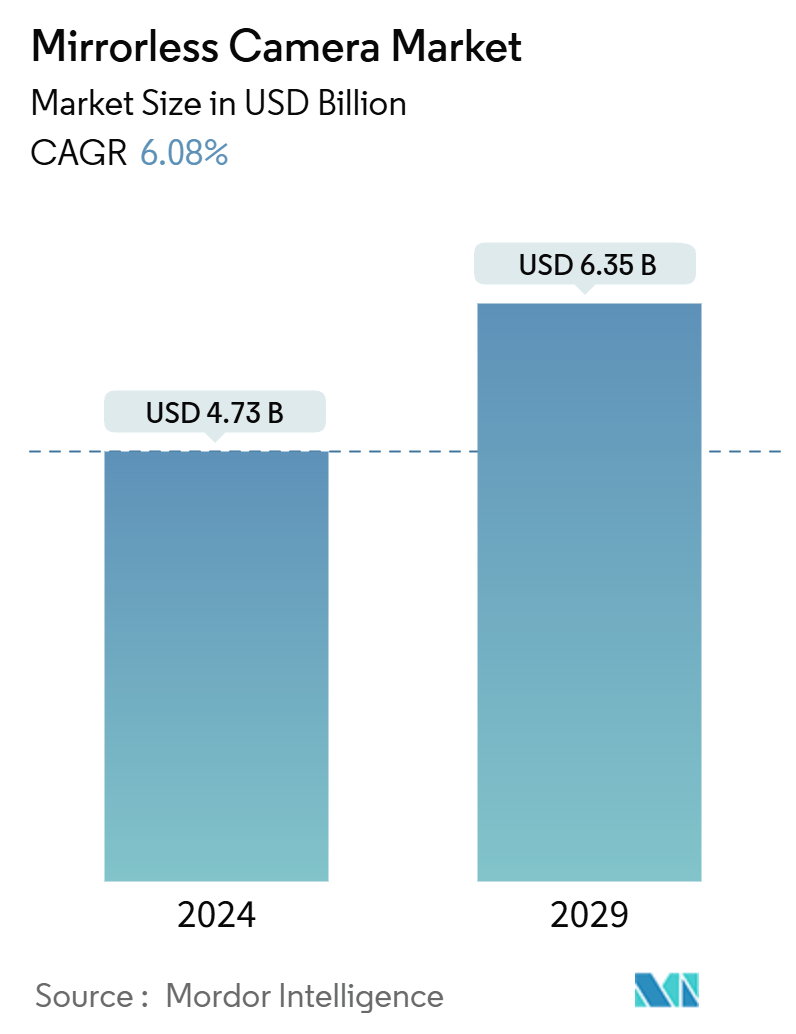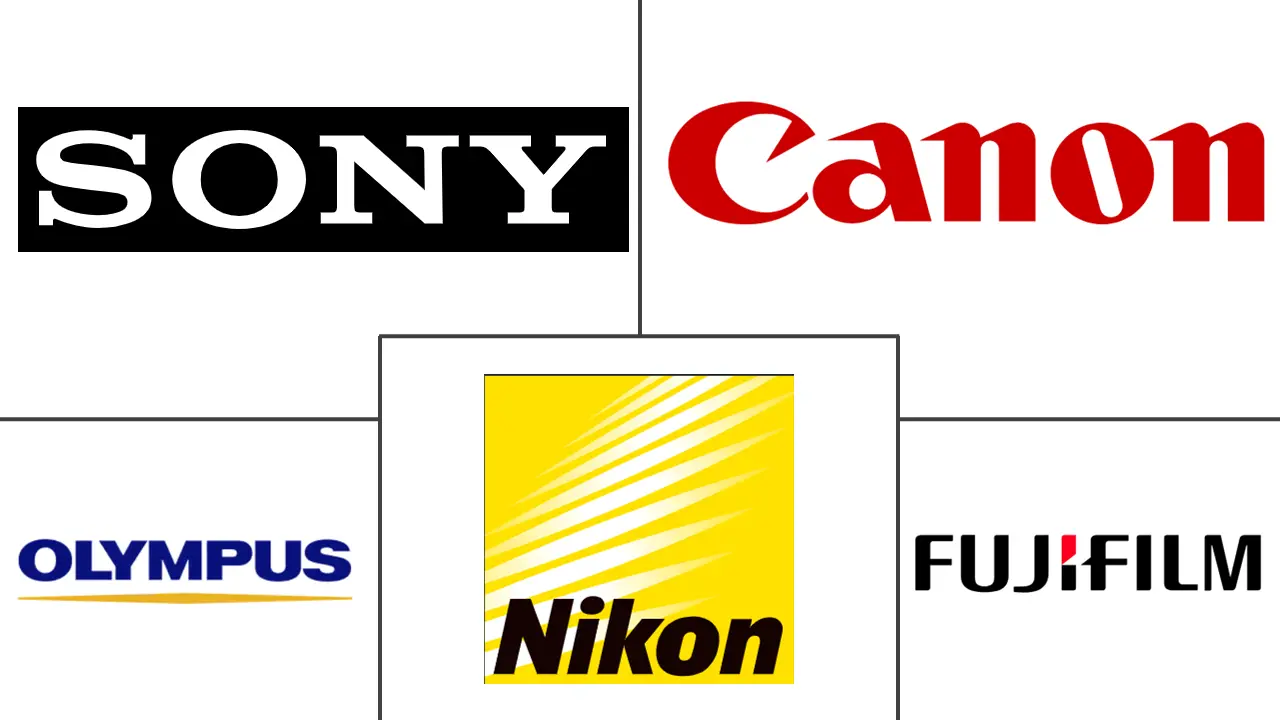Market Size of Mirrorless Camera Industry

| Study Period | 2019 - 2029 |
| Market Size (2024) | USD 4.73 Billion |
| Market Size (2029) | USD 6.35 Billion |
| CAGR (2024 - 2029) | 6.08 % |
| Fastest Growing Market | Asia Pacific |
| Largest Market | North America |
Major Players
*Disclaimer: Major Players sorted in no particular order |
Mirrorless Camera Market Analysis
The Mirrorless Camera Market size is estimated at USD 4.73 billion in 2024, and is expected to reach USD 6.35 billion by 2029, at a CAGR of 6.08% during the forecast period (2024-2029).
The market is expected to grow in the coming years because of the advancement in innovation of mirrorless camera products. The novel and developed mirrorless cameras feature and have the latest photographic technology, speedy burst shooting, high-resolution sensors, and superb and high-quality video. The mirrorless cameras provide outstanding connectivity and are more compact than a DSLR. Major companies have invested a significant sum in cameras to develop novel photographic solutions for their customers.
- Mirrorless cameras are often regarded as the ideal travel camera as they offer high image quality and features while being more portable and lighter than DSLR cameras. Professional vloggers will employ this to shoot high-quality photos and films. Mirrorless provides an advantage over DLSR in terms of compactness. The increasing use of mirror-less cameras is expected to increase the demand for mirror-less lenses during the forecast period. In recent years, major industry players have committed significant capital to expand their photographic portfolios. Nikon offers the Z6 II, a mirrorless camera featuring a full-frame sensor with a 24.5 MP resolution. The camera also supports 273-point hybrid autofocus.
- Mirrorless single-lens camera shipments are at an all-time high, driven by a revival in Chinese outbound tourism and camera manufacturers introducing new models with AI capabilities that surpass smartphones. The increased tourism and travel drive the market growth. According to the UN's World Tourism Organization (WTO), international passenger numbers more than doubled year-on-year to around 235 million in the first three months of 2023, representing 80% of the level of 2019. Similarly, According to the Camera & Imaging Products Association of Japan (CIPA), global camera shipment data for the first six months of the year shows that mirrorless cameras saw a 20% year-on-year growth to reach CNY 253 billion (USD 17 billion) - a record for the third year in a row.
- The built-in lens offers a fixed focal length, which does not allow the user to zoom in or zoom out. For example, if a photographer has chosen a 24 mm lens, the built-in lens would only provide the photographer with a 24 mm perspective (the user cannot zoom in and out with these prime lenses). With this lens, the user can only shoot from one fixed focal length. Built-in or fixed lens cameras range from vintage models with large image sensors to tiny point-and-shoot devices. Smartphone cameras are technically built-in cameras, but the term is most often used to describe larger cameras that look like DSLRs.
- On the contrary, smartphone cameras' quality has dramatically enhanced in recent years. Most people no longer need to carry or buy a dedicated camera. While photo enthusiasts and specialists are expected to obtain incomparable results with high-end lenses and cameras, current smartphones have images that are certainly enough for the average customer's needs. Consumers increasingly favor smartphones over portable point-and-shoot cameras to benefit from expanded functionality in a single device, which is projected to be a significant issue for this industry.
Mirrorless Camera Industry Segmentation
The market is expected to surge in the coming years because of rising disposable income, changing customer lifestyles and trends, increasing urbanization, and others. Until a few years ago, photography was a field made by the high price of professional photography equipment. With better access to advanced technology and solutions, the gap between photography as a profession and a hobby has been reduced.
The mirrorless camera market is segmented by lens type (built-in or static lens and interchangeable lens), geography ((North America (United States, Canada), Europe (United Kingdom, Germany, France, and Rest of Europe), Asia Pacific (China, Japan, India, South Korea, and Rest of Asia Pacific), Latin America, and Middle East and Africa). The market sizes and forecasts are provided in terms of value USD for all the above segments.
| By Lens Type | |
| Built-in or Static Lens | |
| Interchangeable Lens |
| By Geography | |||||||
| |||||||
| |||||||
| |||||||
| Middle East and Africa | |||||||
| Latin America |
Mirrorless Camera Market Size Summary
The global mirrorless camera market is poised for significant growth, driven by advancements in photographic technology and increasing consumer demand for high-quality, portable imaging solutions. These cameras are gaining popularity due to their compactness and superior features compared to traditional DSLR cameras, making them ideal for travel and professional vlogging. The market is witnessing a surge in shipments, particularly in regions like North America, where the developed consumer electronics sector and a growing photography industry are fueling demand. Major players in the industry, such as Canon, Nikon, and FUJIFILM, are investing heavily in innovative product developments and strategic partnerships to enhance their market presence and cater to the evolving needs of consumers.
The market's expansion is further supported by the introduction of new models with advanced features, such as AI capabilities and interchangeable lenses, which offer users greater flexibility and image-capture options. Despite the rising quality of smartphone cameras, mirrorless cameras continue to attract enthusiasts and professionals seeking superior image quality and functionality. The industry is moderately consolidated, with key players continuously striving to differentiate their products through technological advancements and comprehensive lens offerings. As the demand for mirrorless cameras and lenses grows, the market is expected to experience robust growth, with companies focusing on expanding their product portfolios to meet the diverse needs of photographers and content creators worldwide.
Mirrorless Camera Market Size - Table of Contents
-
1. MARKET INSIGHTS
-
1.1 Market Overview
-
1.2 Industry Attractiveness - Porter's Five Forces Analysis
-
1.2.1 Bargaining Power of Buyers
-
1.2.2 Bargaining Power of Suppliers
-
1.2.3 Threat of New Entrants
-
1.2.4 Threat of Substitutes
-
1.2.5 Intensity of Competitive Rivalry
-
-
1.3 Industry Value Chain Analysis
-
1.4 Assessment of the Impact of COVID-19 on the Market
-
-
2. MARKET SEGMENTATION
-
2.1 By Lens Type
-
2.1.1 Built-in or Static Lens
-
2.1.2 Interchangeable Lens
-
-
2.2 By Geography
-
2.2.1 North America
-
2.2.1.1 United States
-
2.2.1.2 Canada
-
-
2.2.2 Europe
-
2.2.2.1 United Kingdom
-
2.2.2.2 Germany
-
2.2.2.3 France
-
2.2.2.4 Rest of Europe
-
-
2.2.3 Asia Pacific
-
2.2.3.1 China
-
2.2.3.2 Japan
-
2.2.3.3 India
-
2.2.3.4 South Korea
-
2.2.3.5 Rest of Asia Pacific
-
-
2.2.4 Middle East and Africa
-
2.2.5 Latin America
-
-
Mirrorless Camera Market Size FAQs
How big is the Mirrorless Camera Market?
The Mirrorless Camera Market size is expected to reach USD 4.73 billion in 2024 and grow at a CAGR of 6.08% to reach USD 6.35 billion by 2029.
What is the current Mirrorless Camera Market size?
In 2024, the Mirrorless Camera Market size is expected to reach USD 4.73 billion.

